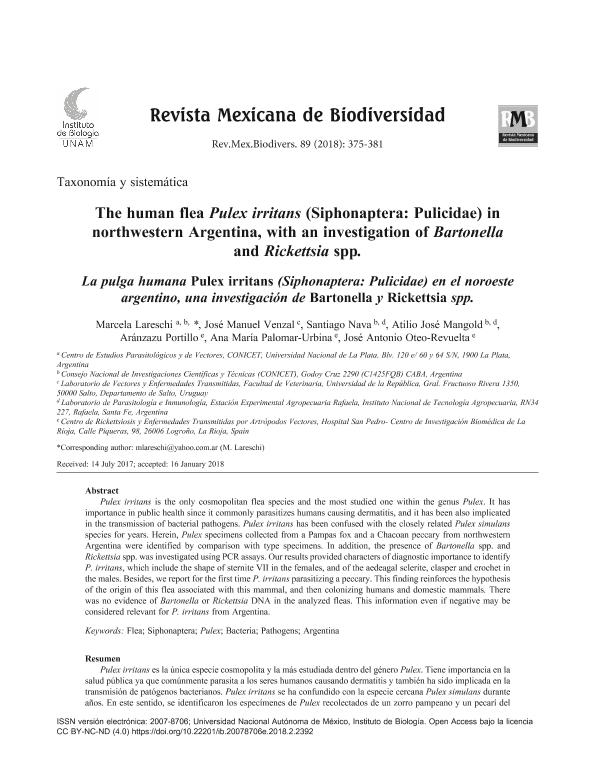Artículo
Pulex irritans es la única especie cosmopolita y la más estudiada dentro del género Pulex. Tiene importancia en la salud pública ya que comúnmente parasita a los seres humanos causando dermatitis y también ha sido implicada en la transmisión de patógenos bacterianos. Pulex irritans se ha confundido con la especie cercana Pulex simulans durante años. En este sentido, se identificaron los especímenes de Pulex recolectados de un zorro pampeano y un pecarí del Chaco del noroeste de la Argentina por comparación con los ejemplares tipo. Además, se investigó la presencia de Bartonella spp. y Rickettsia spp. utilizando ensayos de PCR. Nuestros resultados aportaron caracteres de importancia diagnóstica para identificar a P. irritans, que incluyen la forma del esternito VII en las hembras y del esclerito aedeagal, clasper y crochet en los machos. Además, se reporta por primera vez a P. irritans parasitando un pecarí. Este hallazgo refuerza la hipótesis del origen de esta pulga asociada con este mamífero y luego coloniza humanos y mamíferos domésticos. No hubo evidencia de ADN de Bartonella ni de Rickettsia en las pulgas analizadas. Esta información, si bien negativa, puede ser considerada relevante para P. irritans de Argentina. Pulex irritans is the only cosmopolitan flea species and the most studied one within the genus Pulex. It has importance in public health since it commonly parasitizes humans causing dermatitis, and it has been also implicated in the transmission of bacterial pathogens. Pulex irritans has been confused with the closely related Pulex simulans species for years. Herein, Pulex specimens collected from a Pampas fox and a Chacoan peccary from northwestern Argentina were identified by comparison with type specimens. In addition, the presence of Bartonella spp. and Rickettsia spp. was investigated using PCR assays. Our results provided characters of diagnostic importance to identify P. irritans, which include the shape of sternite VII in the females, and of the aedeagal sclerite, clasper and crochet in the males. Besides, we report for the first time P. irritans parasitizing a peccary. This finding reinforces the hypothesis of the origin of this flea associated with this mammal, and then colonizing humans and domestic mammals. There was no evidence of Bartonella or Rickettsia DNA in the analyzed fleas. This information even if negative may be considered relevant for P. irritans from Argentina.
The human flea Pulex irritans (Siphonaptera: Pulicidae) in northwestern Argentina, with an investigation of Bartonella and Rickettsia spp.
Título:
La pulga humana Pulex irritans (Siphonaptera: Pulicidae) en el noroeste argentino, una investigación de Bartonella y Rickettsia spp.
Lareschi, Marcela ; Venzal, José M.; Nava, Santiago
; Venzal, José M.; Nava, Santiago ; Mangold, Atilio Jose
; Mangold, Atilio Jose ; Portillo, Aránzazu; Palomar Urbina, Ana María; Oteo Revuelta, José Antonio
; Portillo, Aránzazu; Palomar Urbina, Ana María; Oteo Revuelta, José Antonio
 ; Venzal, José M.; Nava, Santiago
; Venzal, José M.; Nava, Santiago ; Mangold, Atilio Jose
; Mangold, Atilio Jose ; Portillo, Aránzazu; Palomar Urbina, Ana María; Oteo Revuelta, José Antonio
; Portillo, Aránzazu; Palomar Urbina, Ana María; Oteo Revuelta, José Antonio
Fecha de publicación:
03/2018
Editorial:
Universidad Nacional Autónoma de México. Instituto de Biología
Revista:
Revista Mexicana de Biodiversidad
ISSN:
1870-3453
Idioma:
Inglés
Tipo de recurso:
Artículo publicado
Clasificación temática:
Resumen
Palabras clave:
ARGENTINA
,
BACTERIA
,
FLEA
,
PATHOGENS
,
PULEX
,
SIPHONAPTERA
Archivos asociados
Licencia
Identificadores
Colecciones
Articulos(CEPAVE)
Articulos de CENTRO DE EST.PARASITOL.Y DE VECTORES (I)
Articulos de CENTRO DE EST.PARASITOL.Y DE VECTORES (I)
Citación
Lareschi, Marcela; Venzal, José M.; Nava, Santiago; Mangold, Atilio Jose; Portillo, Aránzazu; et al.; The human flea Pulex irritans (Siphonaptera: Pulicidae) in northwestern Argentina, with an investigation of Bartonella and Rickettsia spp.; Universidad Nacional Autónoma de México. Instituto de Biología; Revista Mexicana de Biodiversidad; 89; 2; 3-2018; 375-381
Compartir
Altmétricas



